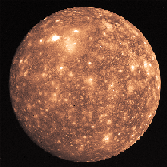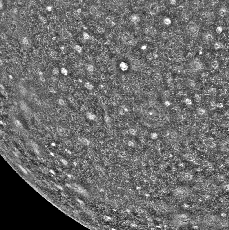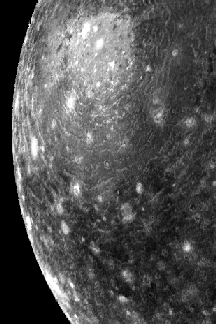The Moon Callisto:
Geologically Dead


The image on the right
(Ref)
shows the moon Callisto, the fourth Galilean satellite.
Callisto, like Ganymede and Europa,
is covered by a frozen water ocean, but unlike the other Galilean
satellites, Callisto is saturated with craters, suggesting very old terrain.
There is no evidence for plate tectonics.
Maximal Cratering Density
The image above left
(Ref)
shows a closeup with more detail of the heavy cratering.
The cratering density on Callisto is essentially maximal, meaning that no
higher density of craters could be formed because the formation of a new crater
would on the average destroy one old crater.

The Valhalla Impact Crater
The image on the left
(Ref)
shows an enormous impact feature on Callisto called
Valhalla. This gigantic meteor impact basin appears to have concentric waves
around it with a diameter of about 3000 km. It is likely that the waves
were formed when the surface ice was melted by a gigantic meteor impact and
then quickly refroze, capturing the waves in a refrozen ice surface.
History of Callisto
Callisto, the most distant Galilean satellite, is only weakly influenced by
Jupiter-induced tides. The evidence suggests that the crust of Callisto
probably froze as it was formed, and essentially nothing has happened
geologically on Callisto for 4.5 billion years except for the influence of
large and small meteor impacts.


